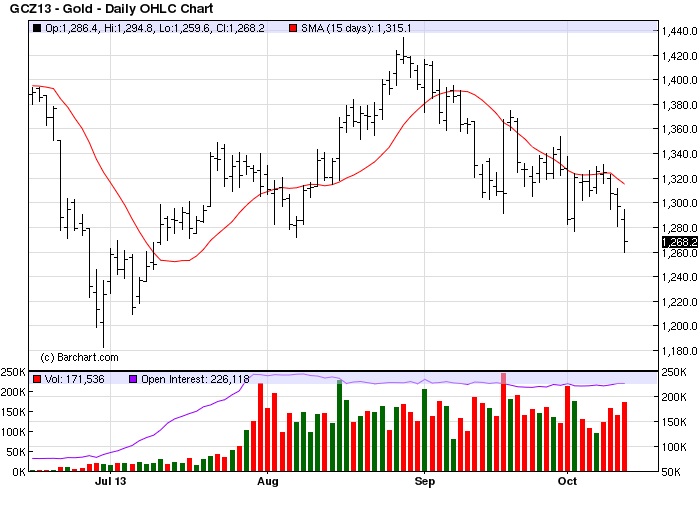Goldman Sachs Strikes Again
Call it the revenge of the gold bears. Jeffrey Currie, the Goldman Sachs chief commodity analyst whose name inspires dread on all gold bugs who hear it, has made yet another bearish prediction for the gold price.
Last week Mr. Currie stated that gold is a “slam dunk” sell because of his expectation that the U.S. economy will extend its recovery after Congress extends the debt ceiling. The price of gold, as if on cue, promptly declined after Currie’s remarks were widely published and it appears that gold is indeed poised for another leg down.
Goldman Sachs’ target for the gold price next year was adjusted to $1,050/oz. “Once we get past this stalemate in Washington, precious metals are a slam dunk sell at that point,” Currie said. “You have to argue that with significant recovery in the U.S., tapering of QE should put downward pressure on gold prices.”
Currie and Ric Deverell, the head of commodities research at Credit Suisse AG, both said on a panel at the Commodities Week conference in London on Oct. 8 that selling gold is their top recommendation for trading in raw materials in the next year. “The downside of driving the bus off the cliff is so significant that we will come to a resolution,” Currie said.
Joining Goldman Sachs and Credit Suisse in its bearish gold outlook for 2014 is Morgan Stanley, which stated on Oct. 10 that it expects the yellow metal will extend its losses once the Federal Reserve begins tapering its QE3 stimulus policy. “We recommend staying away from gold at this point in the cycle,” said Morgan Stanley analyst Joel Crane as reported in Bloomberg.
“Our forecast profile heading into next year is relatively flat against our expectations of rising real interest rates and the U.S. dollar,” Crane told Bloomberg. Morgan Stanley further predicted that gold would average lower every year through 2018.
There are two ways of interpreting the increase in bearish calls on gold by investment bank analysts. On the one hand, as we’ve seen on at least two occasions this year, the banks can be wrong when too many of them pile on the bearish bandwagon. This falls under the contrarian principle of the crowd usually being wrong at major junctures (and yes, that includes institutions at times).
We’ve also seen that the leading institutional banks can be right in their gold forecasts when the metal is highly vulnerable to political moves – especially when the technical trend is down. This appears to be one of those instances, and I’m not unconvinced that analysts like Currie and Deverell purposely wait until these critical junctures arrive before grandstanding with their bearish predictions. It’s interesting that these analysts are nowhere to be seen when gold is in an uptrend; it’s only when a downtrend has been firmly established and gold is at or near a critical chart support (and in danger of breaking under it) that they come out with their bearish proclamations.
Some would say this is a case of high-profile agenda setting rather than accurate prognostication. Whatever the case, the analysts have the trend on their side and traders should be wary about assuming these analysts are wrong. The price of gold (basis December futures) is still under its 15-day moving average (see above), which tells us the dominant immediate-term trend is still down. Until this downtrend is decisively broken, the sellers are assumed to be in control.
********
High Probability Relative Strength Trading
Traders often ask what is the single best strategy to use for selecting stocks in bull and bear markets? Hands down, the best all-around strategy is a relative strength approach. With relative strength you can be assured that you’re buying (or selling, depending on the market climate) the stocks that insiders are trading in. The powerful tool of relative strength allows you to see which stocks and ETFs the “smart money” pros are buying and selling before they make their next major move.
Find out how to incorporate a relative strength strategy in your trading system in my latest book, High Probability Relative Strength Analysis. In it you’ll discover the best way to identify relative strength and profit from it while avoiding the volatility that comes with other systems of stock picking. Relative strength is probably the single most important, yet widely overlooked, strategies on Wall Street. This book explains to you in easy-to-understand terms all you need to know about it. The book is now available for sale at:
http://www.clifdroke.com/books/hprstrading.html
Order today to receive your autographed copy along with a free booklet on the best strategies for momentum trading. Also receive a FREE 1-month trial subscription to the Gold & Silver Stock Report newsletter.

















